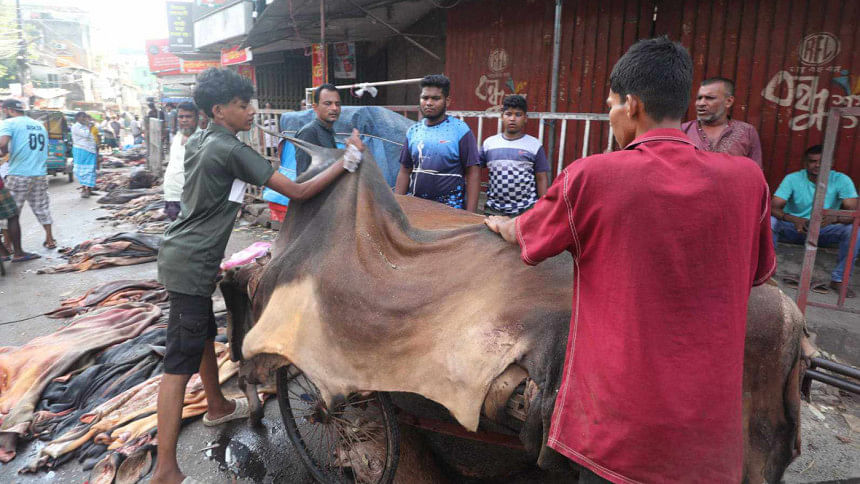Low rawhide prices frustrate traders

Rawhide prices during Eid-ul-Azha have once again dropped below government-set rates across the country, frustrating traders and raising concerns about the effectiveness of recent policy steps, including the temporary lifting of the export ban on raw and wet blue leather.
On May 26, the Ministry of Commerce set the price of salted cowhide at Tk 60–65 per square foot in Dhaka and Tk 55–60 outside the capital, an increase of Tk 5 from last year.
The minimum price of cowhide in Dhaka was set at Tk 1,350 and Tk 1,150 outside the city, while salted goat hides were priced at Tk 20 to Tk 22 per square foot.
However, actual transactions mostly took place at lower rates, with many buyers offering prices similar to last year's.
In some cases, raw unsalted cowhides were sold at Tk 700–900 for large and medium sizes, while lower-quality hides fetched only Tk 600–650.
Prices were reportedly even lower in districts outside Dhaka, and demand for goat hides remained weak.
Despite this, wholesalers and tannery owners said they aimed to collect 80–85 lakh pieces of rawhide this year and claimed they were offering slightly better prices than last year.
However, many seasonal traders said they failed to get fair prices, with some reporting lower rates than last Eid.
Typically, large cowhides range from 31–40 square feet, medium from 21–30 square feet, and small from 16–20 square feet. According to fixed rates, a 25-square-foot salted cowhide in Dhaka should sell for Tk 1,500–1,625.
Tipu Sultan, general secretary of the Bangladesh Hide and Skin Merchants' Association, said rawhide was not bought or sold at government-fixed prices. "We bought medium and large-sized hides at Tk 750–800," he said, adding that traders do not have enough funds.
He noted their target was to collect 100,000 hides this Eid, of which they had gathered around 80,000.
The government recently relaxed export restrictions on raw and wet blue leather for three months to boost local demand and prices. It also disbursed Tk 220 crore in incentives.
PRICES LOWER OUTSIDE DHAKA
In Chattogram, rawhide traders struggled to sell their stock, with many households forced to donate or dispose of unsold hides due to a lack of buyers.
Despite official price announcements, most transactions occurred at significantly lower rates.
Abdus Sabur from Halishahar said no one came to buy his cowhide, and he eventually donated it. A similar situation was reported in other areas.
Seasonal trader Atikur Rahman bought 170 cowhides at Tk 350 each but had to sell them for Tk 250 apiece.
Moslem Uddin, former vice president of the Chattogram Rawhide Warehouse Traders' Cooperative Association, said government rates apply only to processed hides.
This year, cowhide was sold for Tk 600 to Tk 700 per piece, he added.
In the Rangpur division, rawhide traders are finding it difficult to recover their capital.
Tariqul Islam from Gangachara upazila borrowed Tk 3 lakh and bought each cowhide for Tk 100-200, expecting to sell them for up to Tk 1,000.
"The current offers don't even cover processing costs," he said.
Similar frustrations were echoed by traders in Kurigram, Lalmonirhat, and Nilphamari, who now face high storage costs and declining leather quality due to inadequate preservation facilities.
In Moulvibazar, madrasas and orphanages, which traditionally rely on rawhide sales for funding, were shocked to find hide prices drop to Tk 250–300 on Eid day.
Md Shakawat Ullah, senior vice chairman of the Bangladesh Tanners Association, said the supply of cowhides is good this year, with a higher proportion of smaller hides.
He said prices have increased by Tk 100 to Tk 150 per hide compared to last year.
According to him, around 400,000 hides were collected over two days—Eid day and the following day.
On Monday, Commerce Adviser Sheikh Bashir Uddin said Bangladesh's leather industry has been struggling for 15 years and cannot recover quickly due to deep-rooted syndicates.
"I'm personally visiting various regions to break the grip of these syndicates," he said.
To stabilise rawhide prices, the government distributed 7.5 lakh tonnes of salt to help preserve hides, Bashir added.
He also blamed seasonal traders' lack of awareness for major losses during Eid.
The adviser also said efforts are ongoing to boost global demand for Bangladeshi leather goods.
WHY PRICES STAY LOW
In 2003, the government began moving the leather industry from Hazaribagh to a planned industrial park in Savar to reduce pollution.
But 21 years later, the Savar Tannery Industrial Estate is still not fully eco-friendly.
The central effluent treatment plant on the estate, built on 200 acres of land, is still not fully functional, polluting the nearby Dhaleshwari river.
Due to the persistent pollution problem in the estate, renowned international brands and buyers avoid buying leather from Bangladesh directly.
As a result, China has become the main buyer of Bangladeshi leather, but the Chinese offer lower prices.

 For all latest news, follow The Daily Star's Google News channel.
For all latest news, follow The Daily Star's Google News channel. 





Comments